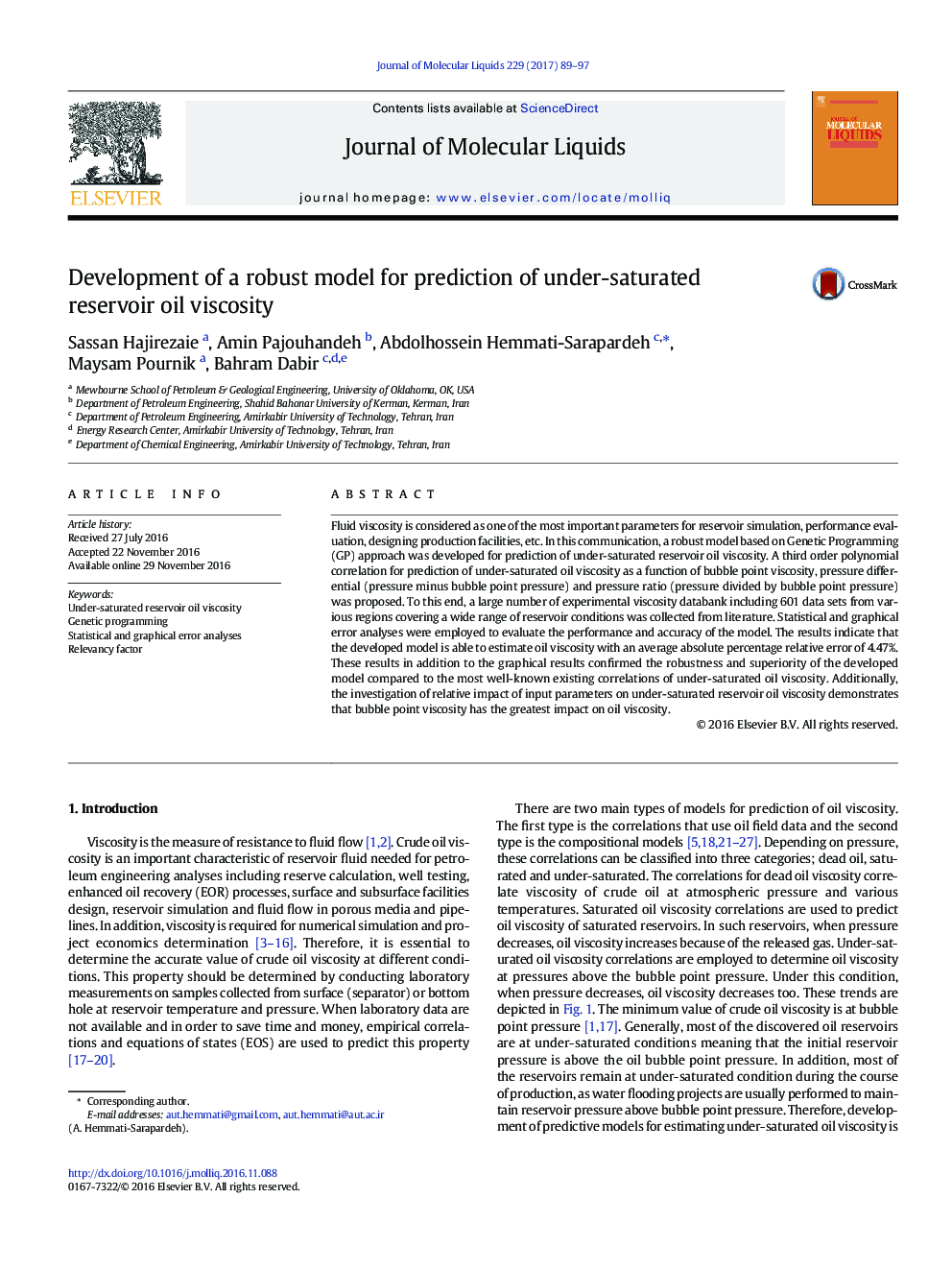| کد مقاله | کد نشریه | سال انتشار | مقاله انگلیسی | نسخه تمام متن |
|---|---|---|---|---|
| 5409127 | 1506542 | 2017 | 9 صفحه PDF | دانلود رایگان |
عنوان انگلیسی مقاله ISI
Development of a robust model for prediction of under-saturated reservoir oil viscosity
ترجمه فارسی عنوان
توسعه یک مدل قوی برای پیش بینی ویسکوزیته نفت مخزن تحت اشباع
دانلود مقاله + سفارش ترجمه
دانلود مقاله ISI انگلیسی
رایگان برای ایرانیان
کلمات کلیدی
ویسکوزیته نفت مخزن زیر اشباع، برنامه نویسی ژنتیک، تجزیه و تحلیل خطا و آماری، عامل پذیرش،
ترجمه چکیده
ویسکوزیته سیال به عنوان یکی از مهمترین پارامترهای شبیه سازی مخزن، ارزیابی عملکرد، طراحی امکانات تولید و غیره در نظر گرفته می شود. در این ارتباط یک مدل قوی بر اساس رویکرد برنامه ریزی ژنتیکی برای پیش بینی ویسکوزیته نفت مخزن تحت اشباع . همبستگی چندجملهای مرتبه سوم برای پیش بینی ویسکوزیته روغن زیر اشباع به عنوان عملکرد ویسکوزیته نقطه حباب، فشار دیفرانسیل (فشار منو فشار نقطه حباب) و نسبت فشار (فشار تقسیم بر فشار نقطه حباب) پیشنهاد شده است. برای این منظور، تعداد زیادی از پایگاه داده تجربی ویسکوزیته شامل 601 مجموعه داده از مناطق مختلف که طیف وسیعی از شرایط مخزن را پوشش می دهند، از ادبیات جمع آوری شد. برای ارزیابی عملکرد و دقت مدل، از تجزیه و تحلیل آماری و گرافیکی استفاده شده است. نتایج نشان می دهد که مدل توسعه یافته قادر به تخمین ویسکوزیته روغن با میانگین خطای نسبی مطلوب 0.447٪ می باشد. این نتایج علاوه بر نتایج گرافیکی، قوی و برتری مدل توسعه یافته را در مقایسه با همبستگی های شناخته شده موجود در ویسکوزیته نفت زیر اشباع نشان داد. علاوه بر این، بررسی تاثیر نسبی پارامترهای ورودی بر ویسکوزیته نفت مخزن زیر اشباع نشان می دهد که ویسکوزیته نقطه حباب دارای بیشترین تاثیر بر ویسکوزیته روغن است.
موضوعات مرتبط
مهندسی و علوم پایه
شیمی
شیمی تئوریک و عملی
چکیده انگلیسی
Fluid viscosity is considered as one of the most important parameters for reservoir simulation, performance evaluation, designing production facilities, etc. In this communication, a robust model based on Genetic Programming (GP) approach was developed for prediction of under-saturated reservoir oil viscosity. A third order polynomial correlation for prediction of under-saturated oil viscosity as a function of bubble point viscosity, pressure differential (pressure minus bubble point pressure) and pressure ratio (pressure divided by bubble point pressure) was proposed. To this end, a large number of experimental viscosity databank including 601 data sets from various regions covering a wide range of reservoir conditions was collected from literature. Statistical and graphical error analyses were employed to evaluate the performance and accuracy of the model. The results indicate that the developed model is able to estimate oil viscosity with an average absolute percentage relative error of 4.47%. These results in addition to the graphical results confirmed the robustness and superiority of the developed model compared to the most well-known existing correlations of under-saturated oil viscosity. Additionally, the investigation of relative impact of input parameters on under-saturated reservoir oil viscosity demonstrates that bubble point viscosity has the greatest impact on oil viscosity.
ناشر
Database: Elsevier - ScienceDirect (ساینس دایرکت)
Journal: Journal of Molecular Liquids - Volume 229, March 2017, Pages 89-97
Journal: Journal of Molecular Liquids - Volume 229, March 2017, Pages 89-97
نویسندگان
Sassan Hajirezaie, Amin Pajouhandeh, Abdolhossein Hemmati-Sarapardeh, Maysam Pournik, Bahram Dabir,
